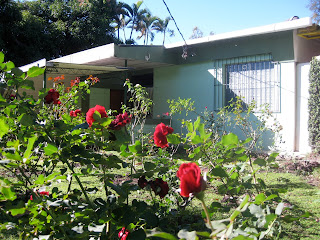The Jardín de Rosas is in a quiet corner of the University of Central America’s (UCA) campus. In the back of a two- story office building turned educational center the garden itself is roped off.
The flowers bloom and sway on stems, reaching up and out as if ready to ask you a question.
It is hard to imagine such a tranquil place filled with the six bodies of Jesuit priests, their housekeeper and her daughter. But the photo albums in the building bellow give witness to the horrors that occurred here 20 years ago.
On the last day of a 10-day trip I took to El Salvador with my school we visited the Jardin de Rosas. For several years Regis University has been sending a delegation of students and faculty to El Salvador to learn about the culture and the impact of the civil war. While we had visited massacre sites and heard the stories of guerrillas that had been detained and tortured by the government, this was by far the hardest and most graphic experience of the trip.
During the civil war in El Salvador (1980-1992) the Jesuits, especially those on the UCA campus, were thought to be safe from the violence of the conflict. The students who attended the school were from affluent families and much of the violence, so common everywhere else in the country, had yet to reach these halls.
But thoughts are a dangerous weapon, more so when you speak them aloud and they become down right lethal when you have an audience. The Jesuits who were killed here taught their students to think critically about the war and the role both sides were playing. Who had the power, who was committing war crimes, who was right and what should they, the people of El Salvador, do about it?

When the army came and killed the priests, they cut open their heads and scattered their brains next to their bodies.
The message was clear- don’t think. Don’t question the government. Don’t speak up.
Looking at these pictures was hard. Very hard. I had heard the story of the Jesuit martyrs before and had created pictures in my head, but nothing can compare to a five by seven color photograph of a man with his head beaten in.
My horror towards the event of that day, and the war itself, it compounded and magnified by the fact that many of the soldiers sent to kill these priests were trained in the United States. Our very own Fort Benning, Georgia is home to a training school for Latin American military where they are taught, among other things, how to use torture and intimidation to control the peoples of their home countries.

Last November I also participated in a school trip to protest this school. I have been there several years in a row now and the experience is always a reminder to be conscious and present to what our government is doing with our tax money. We do not support a school for assassins. When we protest the school, we are also protesting the murder of social activists in Latin American countries. At the school I see one half of a violent equation, that of the military. In El Salvador, I see the other half, the people and places where the combat training is used to wreck havoc.
Finding this connection between a school in the US and a school in El Salvador has got me thinking about our government and our role in the world. I start to ask the same questions that were so important 20 years ago to the 6 Jesuit martyrs, and find they are still relevant today. I ask: who has the power, who is committing war crimes, who is right and what should we, the people of the United States, do about it?
Rose Aspholm is a resident of the Romero House at Regis University. She has been interning for the AFSC since September.












1 comment:
Rose,
This is beautiful, thank you so much for sharing your words.
Love, jordan t
Post a Comment